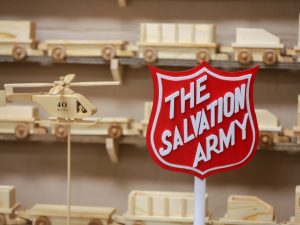If there were a single adjective to describe disasters of recent memory, it would likely be “unprecedented.”
Wildfires have sparked suddenly and quickly burned out of control, incinerating established towns. Hurricanes have formed with surprising speed and intensity, unabashedly appearing outside regimented seasons and locations. Rain, so much rain, has blanketed areas that are ill-equipped to handle such ferocious storms, leading to flooding and mudslides in steady succession.
And that’s without mentioning the consequences of when land has become too dry, or shook, or covered in heavy snow. All of that has happened, too. It seems like more and more disasters are happening all at once.
According to the National Oceanic and Atmospheric Administration, 28 separate billion-dollar natural disasters occurred in the United States in 2023, a record that the chief scientist attributes to a changing climate. In nearly every weather event imaginable—heat, rain, storms, snow—a subsequent disaster occurred.
“One thing about disasters is that they don’t discriminate,” said Ian Anderson, Director of Emergency/Disaster Services (EDS) and Service Extension in The Salvation Army’s Intermountain Division. “They can impact everyone and anyone.”
In August 2023, when a dry wind blew across the island of Maui, it ignited somewhere in the mountainous brush and brought a worst-case scenario to the historic coastal town of Lahaina below. Smoke and flames killed dozens of people and engulfed nearly every structure, forcing some survivors to jump into the ocean for safety.
The wildfire became the worst natural disaster in Hawaii’s modern history, and yet another bullet point showcasing environmental extremes. But if there could be a foil to unprecedented disasters, perhaps it’s found in high levels of preparedness.
In the aftermath of devastation, a network of organizations swoop in to provide care—and given how regularly these disasters have occurred, knowing this safeguard exists can be its own form of solace in the future.
“There is a framework that we’ve been using for catastrophic events for decades,” said John Berglund, EDS Director for the Western U.S. “It continues to improve, but it is a well-oiled and time-tested machine.”
“One thing about disasters is that they don’t discriminate.”
Ian Anderson, Director of Emergency/Disaster Services and Service Extension
The Salvation Army is one of the most recognizable service organizations in the country, and when disaster strikes, Anderson said people expect it to respond. It does so by partnering with federal, state, local and community-based organizations to provide necessities from three meals a day and shelter to even linens on a new bed.
In Lahaina, Berglund said The Salvation Army was present for survivors on day one. It was tasked with mass-care feeding, in which a government contract allowed The Salvation Army to provide roughly a million meals, but its wide-ranging teams did much more than that.
“Picture a large community center, where one side of the room is lined with nonprofit agencies and the other has government agencies,” Berglund said. “Our presence in that center was to have one-on-ones with survivors to provide financial assistance, emotional and spiritual care and other services or referrals for long-term recovery. Almost everyone lost everything, including loved ones.”
This robust response to disasters is tested and built when one isn’t happening, of course, and The Salvation Army is planning for them when a nightmare of what-ifs seems impossible.
The safety net that’s formed is structured over countless conversations around who knows what and how best to address a problem—with which equipment, people, funds—and every potential scenario is tailored to the distinct threats posed in different regions of the country.
Anderson and Berglund noted how an emergency in Anchorage looks different from one in Phoenix, just as it would in Seattle versus Denver. The one detail that may connect every location, though, is how strong their preparedness response may be.
“We spend a lot of time working with various organizations to meet the needs of any one community, and the list can go on and on,” Anderson said. “We want to be able to work alongside them, but we don’t want to overlap or get in anyone’s way. This is in addition to how The Salvation Army addresses needs daily, such as supporting the most vulnerable members of communities. It’s a delicate balance.”
Berglund said the entire system relies on building relationships everywhere, from government agencies like FEMA and non-profits like the Red Cross, to faith and non-faith-based groups.
The Salvation Army also routinely trains volunteers and re-trains staff who may have gotten rusty without a disaster, and inspects equipment that’s stored for the occasion.
“You have to position yourself to have a seat at the table, because if you’re not at the table assisting with these types of decisions then you’re a part of the meal—devoured,” Berglund said.
And yet, as much as Berglund and Anderson are confident in the soundness of their plans, knowing one can be deployed at a moment’s notice as it was in Hawaii, some details could use support. “With disasters happening so frequently now, donor fatigue is very real,” Anderson said. “So one big challenge we’re facing is how to be even better stewards with the money we receive.”
They agree an era prone to disasters requires a flexible and versatile response. And they always have one ready to go.
“The Salvation Army works almost like an accordion—we can pump it up or down,” Berglund said. “In a disaster, we can pull from all of the resources we have to address the needs of a specific incident at a particular time. We know how to fill that gap, and we know we can.”
Do Good:
- See how The Salvation Army fights disaster.












